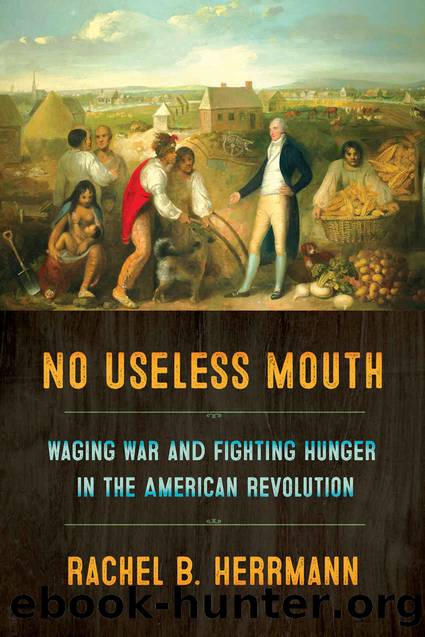No Useless Mouth: Waging War and Fighting Hunger in the American Revolution by Rachel B. Herrmann

Author:Rachel B. Herrmann [Herrmann, Rachel B.]
Language: eng
Format: epub
Tags: History, Military, United States, Social Science, Agriculture & Food, Revolutionary, Modern, General
ISBN: 9781501716126
Google: Pex-DwAAQBAJ
Publisher: Cornell
Published: 2019-11-15T14:00:32+00:00
* * *
The Treaty of Greenville, in combination with mid-1790s treaties between the United States and Great Britain and the United States and Spain, enabled the government to adopt a less compromising Indian food policy from a position of greater strength.28 During the 1790s and early 1800s, Creek, Cherokee, and Iroquois collaborators helped U.S. Indian agents turn the ploughshares of agriculture into the sword of victual imperialism. Officials, in response to Indian claims about hunger, expanded their victual imperialism to include the introduction of fixed prices for foodstuffs. Because Native Americans approved of this price-fixing, the U.S. government was also able to standardize methods of distributing provisions, and to begin thinking about ways to cut down on the quantities of food they dispensed. By the 1810s these changes had reduced Indian land holdings, circumscribed the amount of food aid given to Indians (who were portrayed as increasingly hungry), and turned such food aid into a weapon that destroyed Native bodies.
U.S. officials could not promote the Plan of Civilization without help from Native collaborators, who advised them on everything from land cessions to Indian tastesâsometimes to the detriment of other Indians. Hendrick Aupaumut aided the Americans in 1793 by telling them about Native food preferences, but his efforts were likelier more useful to Americans than they were to Native Americans. It was Aupaumut who suggested that the Americans save money by substituting flour instead of corn âevery fourth dayâ of provisions distributions to the Iroquois. There is some evidence that increased wheat consumption was tied to increased risk of anemiaâthough, of course, late-eighteenth-century eaters would not have put it in quite those terms.29
Other Indians facilitated land sales. The U.S. government arranged the Treaty of New York through the cooperation of Alexander McGillivray. It was because of McGillivray that Creeks received âa Number of Ploughs & other implements of husbandryâ from James Seagrove. For his part McGillivray secured a spot as a brigadier general in the United States army, as well as the right to import tax-free goods through Pensacola, Florida. Although the practice of making side deals persisted, the men making them fall into and out of the records. Alexander McGillivray died in 1793. By that point in time, Cornplanter had fallen from power, and Dragging Canoe was also dead.30 New partnerships would form as a result of Benjamin Hawkinsâs work with southern Indians.
In A Sketch of the Creek Country in the Years 1798 and 1799, first published in 1848 by the Georgia Historical Society, U.S. Indian agent Benjamin Hawkins described his approach to the Plan of Civilization and his method of forging collaborative ties with Native Americans. Hawkinsâs travels to Indian towns to provide instruction in plow use resembled Samuel Kirklandâs methods earlier in the decade. Like Pickering, he did not want to send Indian children to faraway schools, and he expanded on both Pickeringâs and Kirklandâs ideas by constructing a model farm. He also distributed provisions. One striking difference between the southern arm of the Plan of Civilization and
Download
This site does not store any files on its server. We only index and link to content provided by other sites. Please contact the content providers to delete copyright contents if any and email us, we'll remove relevant links or contents immediately.
| Canada | Caribbean & West Indies |
| Central America | Greenland |
| Mexico | Native American |
| South America | United States |
Cat's cradle by Kurt Vonnegut(15186)
Pimp by Iceberg Slim(14394)
4 3 2 1: A Novel by Paul Auster(12284)
Underground: A Human History of the Worlds Beneath Our Feet by Will Hunt(12024)
The Radium Girls by Kate Moore(11921)
Wiseguy by Nicholas Pileggi(5671)
Perfect Rhythm by Jae(5324)
American History Stories, Volume III (Yesterday's Classics) by Pratt Mara L(5256)
The Fire Next Time by James Baldwin(5249)
Paper Towns by Green John(5090)
Pale Blue Dot by Carl Sagan(4912)
A Higher Loyalty: Truth, Lies, and Leadership by James Comey(4845)
The Mayflower and the Pilgrims' New World by Nathaniel Philbrick(4423)
The Doomsday Machine by Daniel Ellsberg(4416)
Killers of the Flower Moon: The Osage Murders and the Birth of the FBI by David Grann(4386)
The Sympathizer by Viet Thanh Nguyen(4305)
Too Much and Not the Mood by Durga Chew-Bose(4274)
The Borden Murders by Sarah Miller(4247)
Sticky Fingers by Joe Hagan(4101)
